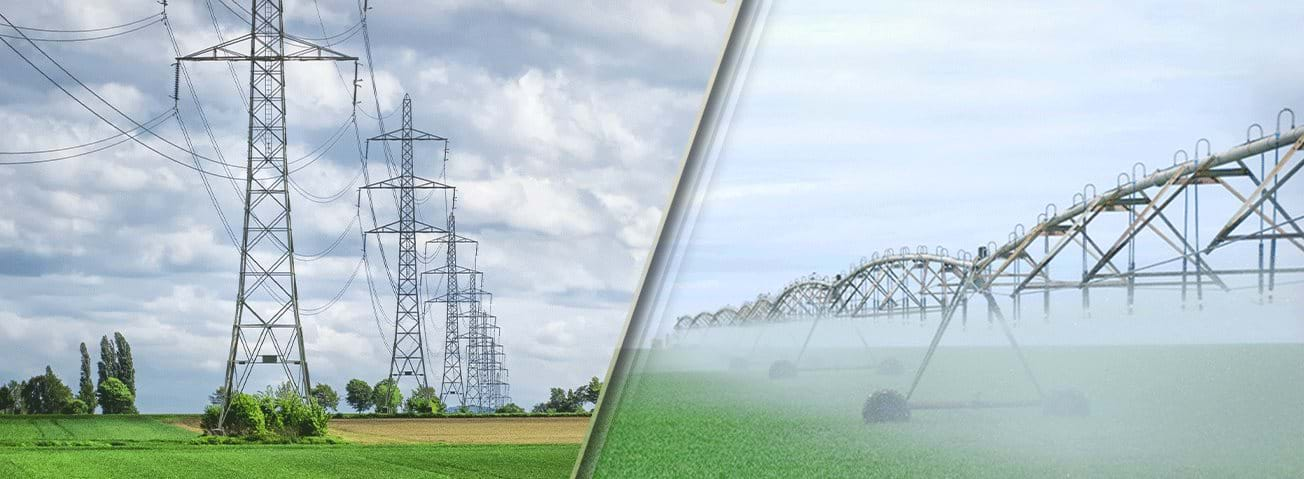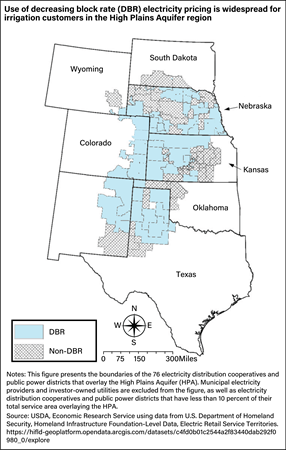Energy Pricing Structures Promote Increased Use of Scarce Groundwater Resources in the High Plains Aquifer Region

Groundwater supports irrigated agricultural production throughout the United States. However, in many of the most agriculturally productive aquifers in the United States, rates of pumping exceed natural recharge, which decreases groundwater stocks. Persistent decreases in groundwater stocks threaten the future of groundwater-fed irrigated agriculture.
The High Plains Aquifer (HPA, also known as the Ogallala Aquifer) is among the most important groundwater resources in the United States, underlying areas in eight States of the Central United States: Colorado, Kansas, Nebraska, New Mexico, Oklahoma, South Dakota, Texas, and Wyoming. It supports irrigated agricultural production and provides drinking water for residential use among other uses. Intensive pumping of the HPA for agriculture and other purposes has led to growing concerns about the depletion of the aquifer and the future of the irrigated agricultural sector it supports.
Irrigating with groundwater requires energy to pump water from the aquifer to the field. For much of the groundwater-fed irrigated agriculture in the HPA region, the energy costs incurred when pumping groundwater is the only explicit price paid for water. There are multiple sources of energy for groundwater pumping, such as diesel fuel, natural gas, and propane, but electricity is the primary source of energy for agricultural groundwater users in the HPA region. Many electricity providers in the region use decreasing block rate (DBR) price structures for irrigation customers. Farmers choose the amount of water to pump by balancing the costs and benefits of additional water. The DBR electricity pricing structure creates an incentive for irrigators to use more electricity and water than a uniform pricing structure because the energy costs of water decrease as pumping increases.
An analysis of groundwater pumping and electricity consumption data from a study area consisting of two electricity cooperatives in eastern Colorado reveals that the cooperatives’ use of DBR pricing increases groundwater use by about 11 percent compared to a uniform electricity pricing scenario that generates the same revenue for the cooperative. This relationship between groundwater pumping decisions and electricity price structure has important implications for the future of the HPA, as more than half of the electricity cooperatives in the region use DBR pricing for irrigation customers.
Impacts of Block-Rate Energy Pricing on Groundwater Demand in Irrigated Agriculture, by Manning, D., J. Suter, and C. Goemans, American Journal of Agricultural Economics, May 2021
Irrigation & Water Use, by Aaron Hrozencik, USDA, Economic Research Service, September 2023
Irrigation Organizations: Water Storage and Delivery Infrastructure, by Aaron Hrozencik, Steven Wallander, and Marcel Aillery, ERS, October 2021
Resource Requirements of Food Demand in the United States, by Patrick Canning, Sarah Rehkamp, Claudia Hitaj, and Christian J. Peters, ERS, May 2020
Irrigation Organizations: Drought Planning and Response, by Steven Wallander, Aaron Hrozencik, and Marcel Aillery, ERS, January 2022
Trends in U.S. Irrigated Agriculture: Increasing Resilience Under Water Supply Scarcity, by Aaron Hrozencik and Marcel Aillery, ERS, December 2021


